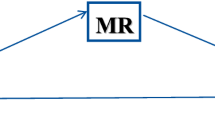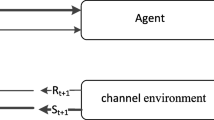Abstract
A dynamic machine learning algorithm is described for predicting the probability of successful signal transmission and adaptive signal modulation and coding in a massive MIMO (Multiple Input Multiple Output) system. The algorithm is based on a fully connected neural network, which is initially trained on the output of the standard OLLA (Outer Loop Link Adaptation) algorithm, and then gradually trained on the basis of feedback from the wireless system. Numerical modeling of the MIMO system is done in different scenarios to confirm the quality of the proposed algorithm, using different characteristics of the communication channel and speeds of the served users. The advantage is shown of the proposed algorithm over the modern Q-learning algorithm and the standard OLLA scheme.




Similar content being viewed by others
REFERENCES
S. T. Chung and A. J. Goldsmith, ‘‘Degrees of freedom in adaptive modulation: a unified view,’’ IEEE Trans. Commun. 49 (9), 1561–1571 (2001). https://doi.org/10.1109/26.950343
H. Huh, A. M. Tulino, and G. Caire, ‘‘Network MIMO with linear zero-forcing beamforming: Large system analysis, impact of channel estimation, and reduced-complexity scheduling,’’ IEEE Trans. Inf. Theory 58 (5), 2911–2934 (2012). https://doi.org/10.1109/TIT.2011.2178230
A. Sampath, P. S. Kumar, and J. M. Holtzman, ‘‘On setting reverse link target SIR in a CDMA system,’’ in 1997 IEEE 47th Vehicular Technology Conference. Technology in Motion, Phoenix, AZ, USA, May 4–7, 1997 (IEEE, 1997), Vol. 2, pp. 929–933. https://doi.org/10.1109/VETEC.1997.600465
P. Song and S. Jin, ‘‘Performance evaluation on dynamic dual layer beamforming transmission in TDD LTE system,’’ in 2013 Third International Conference on Communications and Information Technology (ICCIT), Beirut, Lebanon, 19–21 June 2013 (IEEE, 2013), pp. 269–274. https://doi.org/10.1109/ICCITechnology.2013.6579562
K. I. Pedersen, G. Monghal, I. Z. Kovacs et al., ‘‘Frequency domain scheduling for OFDMA with limited and noisy channel feedback,’’ in 2007 IEEE 66th Vehicular Technology Conference, Baltimore, MD, USA, 30 September – 3 October 2007 (IEEE, 2007), pp. 1792–1796. https://doi.org/10.1109/VETECF.2007.378
F. Blanquez-Casado, G. Gomez, M. del Carmen Aguayo-Torres, and J. T. Entrambasaguas, ‘‘eOLLA: an enhanced outer loop link adaptation for cellular networks,’’ EURASIP J. Wireless Commun. Networking 2016 (1), 20, 1–16 (2016). https://doi.org/10.1186/s13638-016-0518-3
E. Bobrov, D. Kropotov, H. Lu, and D. Zaev, ‘‘Massive MIMO adaptive modulation and coding using online deep learning algorithm,’’ IEEE Commun. Lett. 26 (4), 818–822 (2022). https://doi.org/10.1109/LCOMM.2021.3132947
J. Gama, I. Žliobaitė, A. Bifet, et al., ‘‘A survey on concept drift adaptation,’’ ACM Comput. Surv. (CSUR) 46 (4), 44, 1–37 (2014). https://doi.org/10.1145/2523813
B. Krawczyk and A. Cano, ‘‘Online ensemble learning with abstaining classifiers for drifting and noisy data streams,’’ Appl. Soft Comput. 68, 677–692 (2018). https://doi.org/10.1016/j.asoc.2017.12.008
C.-K. Wen, W.-T. Shih, and S. Jin, ‘‘Deep learning for massive MIMO CSI feedback,’’ IEEE Wireless Commun. Lett. 7 (5), 748–751 (2018). https://doi.org/10.1109/ICOCN.2019.8934725
D. Wübben, R. Böhnke, V. Kühn, and K.-D. Kammeyer, ‘‘Near-maximum-likelihood detection of MIMO systems using MMSE-based lattice-reduction,’’ in 2004 IEEE International Conference on Communications, Paris, France, 20–24 June 2004 (IEEE, 2004), Vol. 2, pp. 798–802. https://doi.org/10.1109/ICC.2004.1312611
L. Sun and M. R. McKay, ‘‘Eigen-based transceivers for the MIMO broadcast channel with semi-orthogonal user selection,’’ IEEE Trans. Signal Process. 58 (10), 5246–5261 (2010). https://doi.org/10.1109/TSP.2010.2053709
M. P. Mota, D. C. Araujo, F. H. C. Neto et al., ‘‘Adaptive modulation and coding based on reinforcement learning for 5G networks,’’ in Proc. 2019 IEEE Globecom Workshops (GC Wkshps), Waikoloa, HI, USA, 9–13 December 2019 (IEEE, 2019), pp. 1–6 (2019). https://doi.org/10.1109/GCWkshps45667.2019.9024384
L. Zhang, J. Tan, Y.-C. Liang et al., ‘‘Deep reinforcement learning-based modulation and coding scheme selection in cognitive heterogeneous networks,’’ IEEE Trans. Wireless Commun. 18 (6), 3281–3294 (2019). https://doi.org/10.1109/TWC.2019.2912754
G. Tesauro, ‘‘Temporal difference learning and TD-Gammon,’’ Commun. ACM 38 (3), 58–68 (1995). https://doi.org/10.1145/203330.203343
D. P. Kingma and J. Ba, ‘‘Adam: A method for stochastic optimization,’’ arXiv preprint arXiv:1412.6980 (2014).
Author information
Authors and Affiliations
Corresponding author
Additional information
Translated by T. Sokolova
About this article
Cite this article
Bobrov, E.A. An Algorithm Is Described for Predicting the Probability of Success of Signal Transmission in a Wireless Communication System Using Machine Learning. MoscowUniv.Comput.Math.Cybern. 46, 117–124 (2022). https://doi.org/10.3103/S0278641922030037
Received:
Revised:
Accepted:
Published:
Issue Date:
DOI: https://doi.org/10.3103/S0278641922030037




